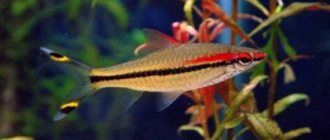- Wild animals
- >>
- Fish
Barbus are one of the most common genera of aquarium fish in terms of numbers. Their distinctive feature is their unpretentiousness - surviving in the harsh conditions of tropical reservoirs, teeming with enemies who want to feast on small fish, barbs will feel very comfortable even in an unkempt aquarium. This species is also remarkable because its representatives have cheerful, bright and varied colors, are unusually active, cheerful and mobile. With the listed qualities, they attract the attention of young aquarists.
Origin of the species and description
Photo: Barbus
Under natural conditions, the genus of barbs inhabits the water basins of China, Africa and (mainly) Southeast Asia. In the wild, all representatives of the Barbus genus, without exception, live in flocks, and in unusually large ones. Ichthyologists believe that this makes it easier for them to get their own food and protect themselves from natural enemies. Whether this is true or not is difficult to say, but this kind of tactic allows the barb population to consistently hold the palm in terms of the number of individuals.
Keeping barbs in artificial conditions presents virtually no difficulties - this is why young aquarists begin their careers with “striped robbers”. The chemical indicators of water, which are necessarily taken into account when choosing a fish breed (meaning hardness and acidity), do not play a special role in the situation under consideration.
Video: Barbus
Regarding water, barbs prefer the old one, which is replaced according to the classic 1/3 version. The variability of water temperature ranges from 20 to 26C. Ideally, maintain a stable temperature of 23-26 degrees. There are several varieties of barbs, differing both in their morphometric indicators (color, size, fin features) and in character.
Why, even their habitats are different! So, most often for aquarists and ichthyologists (these fish are ideal for conducting all sorts of experiments).
We have to deal with the following representatives of the barb genus:
- Sumatran barb;
- fiery barb;
- cherry barb;
- Barbus mutant;
- barbus denisoni;
- black barb;
- scarlet barb;
- shark barb;
- green barb;
- linear barb;
- barbus the clown
Below we will discuss in detail the main representatives of the barb genus, which have become the most widespread and popular. Looking ahead, it is worth saying a few words regarding the species diversity of barbs.
The Denisoni barb will help to destroy all stereotypes regarding these fish - it is not a small “round thing”, as everyone imagines a barb, but a medium-sized fish with an elongated, spindle-shaped body covered with silvery scales. Yes, the classic signs of the barb are preserved - stripes, but unlike other species, they do not run in opposition, but along the body, in the direction from the tip of the snout to the caudal fin.
Aquarium Basics
Barbs are relatively unpretentious pets, for the maintenance of which the following rules must be followed:
- Choose a tank with a volume sufficient to support a flock of 6-10 individuals. Depending on the type of fish, it can be different; for dwarf species, 100 liters is enough; for large ones, sometimes 600 liters and even 1000 liters are needed.
- Temperature range +20…+25 °С.
- Other indicators of the aquatic environment are not so important, although in nature Barbs prefer slightly acidic (6.0-7.5 pH) and soft (up to a maximum of 10 dH) water for the most part. It can be softened by osmosis or passing through a peat filter. Only Barbus Odessa lives in calcareous reservoirs with a high carbon number.
- It is better to choose plants that are floating or have a strong root system. Some Barbs like to dig.
- Shelters are needed not only from aquatic plants, but also from driftwood, stones, and artificial decorations.
- Fish look better against a dark background. It can be used as non-chemically colored pebbles, basalt or gravel with a fraction size of 3-7 mm.
- The tank should be designed in such a way that there is enough space for the flock to move freely - Barbs are very active and mobile.
- Fish in natural habitats live in flowing waters, so weak currents should be simulated using aeration and filtration devices.
- At least one fifth of the water volume must be replaced weekly with clean, settled water.
- Almost all varieties prefer dim lighting.
- It is better to cover the artificial pond with a lid in order to prevent restless Barbs from jumping out and splashing water.
Appearance and features
Photo: What does a barb look like?
When the word “barb” is mentioned in people’s minds (unless, of course, they are ichthyologists), a picture of a yellow striped fish pops up. This is a Sumatran barb, a resident of aquariums of all sizes. The body of this fish is short, high and slightly compressed on the sides.
If you use your imagination, you can come to the conclusion that the body shape of the Sumatran barb is very similar to the body shape of a crucian carp. But the sizes differ - in natural conditions, “striped robbers” do not grow more than 15 cm, and in captivity their sizes do not even exceed 8 cm. And the color is very different - even the more similar yellow crucian carp never has stripes.
The “calling card” of the Sumatran barb is its signature 4 black stripes that cross the body of the fish in the transverse direction. The outer stripes are visible at the tail itself - on one side, and on the other, the stripes pass through the eye. At the end of the dorsal fin there is a bordering red stripe.
The less famous fire barb has an oval body, somewhat elongated in length, but also flattened on the sides. To color this fish, Mother Nature used bright, catchy and quite colorful colors. A distinctive feature of this species is the presence of a noticeable dark spot bordered by a golden circle.
This spot is located on the front of the tail. The scales on the back of the fire barb have a greenish-olive tint, but the sides and abdomen have a bright red, pronounced tint (this was the reason for this name). Unlike the Sumatran barb, “a fighter and a restless fish,” this fish exhibits an amazingly peaceful character and gets along well with all fish, even in a small aquarium. It is best to make contact with its relatives - flocks of barbs lead a restless lifestyle.
Unless conflicts may arise with veil-tails and scalars - seeing their stunning “forms”, even this quiet one will remember his origin. As a result, luxurious tails and fins will be hopelessly damaged. The only exception is goldfish. The barbs do not touch them, even when in a flock - they are afraid. Or they respect it - no one has yet learned to understand the fish language.
Lifespan
Barbs can live in a home aquarium for 3-5 years, provided that acceptable living conditions are created for the pets. The species of large barbs have a long lifespan - up to 10 years, however, it should be noted that the maintenance of such barbs is more difficult than that of small varieties.
Considering the unpretentiousness of the phenotypes, many aquarists treat their pets negligently, believing that barbs are patient fish and will endure anything. This is a common mistake for beginners, because the most common cause of death for barbel fish is improper maintenance. To prevent the death of nimble pets, you should know everything about barbs.
Where does the barb live?
Photo: Barbus fish
Regarding the Sumatran barb, this question is not relevant - from the name it is easy to guess that the main “registration” of this fish is the island of Sumatra and the regions of Southeast Asia nearby. The natural habitats of the fire barb are the water basins of northeastern India.
The main requirement that these bright and cheerful fish place on a pond is the absence of intense current - unpretentious barbs will populate a lake or pond with stagnant water. Rivers with weak currents are also suitable.
Interesting fact: As it turned out, this fish, in addition to aquarists, is very respected by ichthyologists. It has an ideal set of qualities that are vital for conducting experiments with representatives of the class of bony fish.
The homeland of the cherry barb is considered to be Southeast Asia (more specifically, the island of Sri Lanka). The fish lives (in fact, almost like all its relatives) in stagnant and sluggishly flowing reservoirs. Another criterion for the suitability of a reservoir is a dark, silty bottom.
The cherry barb first arrived in Europe in 1936, and in the USSR in 1959. Like the Sumatran, the red barius is a common resident in hobby aquariums. There is also an albino form of the cherry barb, but these individuals are considered mutants and are not in demand among aquarists. Some breeders sell them to beginners at exorbitant prices - under the guise of “rare tropical fish.” And this is where marketing comes in!
The above-mentioned Denisoni barb was originally discovered by the explorer whose name it immortalized in the waters of the Manimala River (near the city of Mundakayam, Kerala, southern India). The species is notable for being endemic to the Indian states of Kerala and Karnataka. Small populations can be found in the Valapatanam, Chalia and Kupam river basins.
But still, the main habitat of almost all representatives of the Barbus genus is the aquarium! An ideal aquarium for any barb should have an elongated, somewhat elongated shape (and in no case round) - this is necessary so that the frisky fish have the opportunity to “get up to speed.” The presence of floating plants, bright lighting, powerful filtration and aeration are necessary conditions for the successful breeding and maintenance of barbs.
Approximately how much do they cost?
Common barbs are sold for 25-30 rubles. for 1 fish. Oligolepis can be bought for 65 rubles. and higher. The cherry barb is already sold for 80, and the Sumatran barb - for 100. A copy of the mossy mutant costs 120 rubles, the five-striped one - 150. For the flaming and fiery barb they ask for 200 rubles. and more. For a colored Sumatran - under 300, and for a Denison barb the price reaches 400 rubles -
It is interesting, and also good for health, to watch colorful and restless barbs play. We hope the article was useful to the reader who is interested in barbs or is just planning to start an aquarium.
If so, please leave a comment or share your own experiences or observations with barbs.
What does the barb eat?
Photo: Female barb
Under natural conditions, fish feed on small insects, bugs, worms, insect larvae, and do not disdain plant foods. Barbs living in an aquarium are treated to the usual food for all aquarium fish - bloodworms and daphnia.
The fish attacks a bloodworm thrown into an aquarium with amazing greed (regardless of whether the barb is hungry or not). At the same time, having swallowed a couple of bloodworms, he swims away from the food sent to the aquarium and does not approach it again.
This once again indicates that these fish are completely unpretentious in feeding; they happily eat both live and dry food. Adult Sumatran barbs need additional plant nutrition, although they themselves manage to find it by plucking aquarium vegetation.
They consume food in the water column, but if necessary, they can search for food both from the surface and from the bottom. Despite all their mobility and active lifestyle, barbs are prone to obesity. Conclusion - for adults it is necessary to arrange one fasting day. Once a week, no more often.
And one more very important point that must be taken into account when selecting neighbors for the barb in the aquarium. In natural living conditions, the barb is the main destroyer of eggs and fry of other fish and frogs. Moreover, the striped robber does not disdain the offspring of anyone, except, of course, his own breed.
Barbs masterfully find even securely hidden masonry and happily feast on caviar, which contains a lot of useful nutrients. Moreover, in captivity, barbs retain such an ugly habit - they will destroy the eggs of any other fish, and will even do this at the risk of their lives.
Well, the barb will not stand aside as long as at least one egg is intact or one fry is alive! Therefore, if you want to breed fish in an aquarium, do not put them together with barbs under any circumstances - they will eat the offspring, 100% guaranteed. And don’t add young animals to them - they, too, will be destined to suffer.
What fish are compatible with barbs: main list
In most cases, barbs are quite peaceful fish, but they are very active, which is why you need to consider which aquarium inhabitants can withstand such a neighborhood and which cannot.
The aquarium must be large enough so that their activity does not interfere with other fish, otherwise conflicts may arise.
It is advisable to choose fish of approximately the same size as barbs. At the same time, keep in mind that if the aquarium is small, then there is a possibility that slower fish (guppies, angelfish, etc.) may suffer greatly from the activity of barbs.
Neighborhood with large predatory fish is excluded. The optimal “neighbors” are swordtails, platies, mollies, zebrafish and other fish that have not only similar sizes, but also approximately the same temperament.
IMPORTANT: Regardless of the type of barb, they should never be placed in the same aquarium with goldfish and other aquarium inhabitants that have long fins. The reason is clear - they will simply be bitten by barbs.
Features of character and lifestyle
Photo: Red Barb
The lifespan of barbs is about 5-6 years in natural conditions, and 3-4 years in captivity (subject to compliance with all the necessary conditions for comfortable living of fish in the aquarium). The life expectancy of all barbs is approximately the same. They live for about five years.
Interesting fact: A favorite pastime of barbs is to sneak up behind veiled lumps and bite off pieces of their fins. They do this because their lush fins themselves cause irritation, taking up too much space in an already limited water space. It is possible that the barbs, modestly decorated by Mother Nature, experience black envy of their overly dressed brothers.
Undemanding, unpretentious barbs will survive even with the most illiterate aquarists - if only there was a water filter and an aerator. That's it, nothing else is needed - and in terms of food, these fish are generally omnivorous, they will eat whatever they give. If you don’t feed them, the barbs will happily eat the leaves of aquarium plants. In extreme cases, other fish will become food - even a cichlid will not be able to resist a flock of barbs.
Barbs show an unhealthy interest in relation to guppies - clumsy fish with beautiful, fluttering tails, causing barbs (mostly Sumatran) to attack unmotivated aggression. They almost never coexist with these fish in the same territory.
Diseases, symptoms, treatment
Barbs have strong natural immunity to most viral and infectious fish diseases. The main cause of Barbus diseases, as a rule, is gross violations of the rules for their maintenance and care.
Ovarian cyst in a female Barbus
A sign of the onset of the disease is excessive enlargement of the female’s abdomen, which is uncharacteristic of pregnancy in the fish.
An ovarian cyst in female Barbs can occur due to constant feeding of them with one (albeit combined) dry concentrated food, as well as as a result of long-term separation of males and females. Due to the chronic course of this disease, it is usually detected too late, when the fish have already become infertile or die.
Therefore, there are no methods for treating this disease, as such, and to prevent it, it is important to use preventive measures - proper varied feeding of Barbs and ensuring harmonious communication between females and males.
Ichthyophthiriasis in Barbs
The cause of the disease is an equiciliated ciliate.
It is the most dangerous ectoparasitic disease, very often leading to the death of not only the entire aquarium population of Barbs, but also other fish in a given aquarium.
A sign of the onset of the disease are small white grains on the body of the fish.
Ichthyophthyriosis should be treated by an experienced ichthyopathologist. Medicines used are “Malachite green”, “Violet “K” and potassium permanganate.
Gill rot (Branchiomycosis)
Gill rot is the most severe disease of Barbs. The reason is a fungal infection, the source of which, most often, is live daphnia and cyclops, capable of forming a specific fungus under conditions of elevated water temperature in the aquarium from +27-32° C.
Fungi infect the gill vascular system of fish, causing it to rot. A sick fish does not eat and is usually located near the surface of the aquarium water.
Positive results from the treatment of this disease are possible only at the very beginning of its manifestation. Griseofulvin and Rivanol are used, diluted in the water of a quarantine aquarium, according to the instructions.
Social structure and reproduction
Photo: Male barb
Barbs in artificial conditions can spawn at almost any time of the year. To allow the fish to successfully spawn, it is necessary to properly select the producers and monitor their preparation for it. The ability to reproduce occurs in fish that have reached the age of approximately 7-8 months, but the process of preparing the breeders itself must be done much earlier.
At the age of 3.5-4 months, the most brightly colored fish are selected from the young, in accordance with the age of the developing fish, and they are moved to a special aquarium. The water temperature there should not go beyond the range of 23-25 C. This is explained by the fact that if the temperature is higher, the barbs will reach sexual maturity faster. But as practice shows, fast does not mean good. The thing is that barbs that reach sexual maturity prematurely do not show their best side in spring spawning.
Breeding of barb chicks is usually carried out in separate pairs. However, the ideal option would be to resettle a small group (the classic option is a female and 2-3 males). This will ensure the maximum percentage of egg fertilization. If the fish were initially prepared correctly, the duration of spawning will be several hours (the process usually occurs in the morning).
Bottom line
The breeds of barbs are so diverse that an aquarist can always choose the ideal option for himself. Aquarium fish are a wonderful hobby that is interesting at any age. Barbs remain one of the most common inhabitants of home ponds due to the variety of forms and because of their undemanding conditions. Barbecue aquariums, which combine several breeds of these fish, look no worse at home than exotic sea ones.
Natural enemies of barbs
Photo: What does a barb look like?
There is one very interesting (and logical) rule that aquarists often forget about. Especially beginners. Either they simply do not take it into account, or they naively believe that due to certain circumstances it will not work. But alas, this is not so.
Those types of fish that are enemies (competitors) of the barb in the natural environment remain the same for it in the aquarium. That is, if barbs stubbornly “do not get along” with cockerels and guppies in tropical reservoirs, then they will also fight with them in the aquarium. Genetic memory, nothing can be done about it. These fish are their enemies for resources, so they definitely won’t be able to live peacefully together.
Another sworn enemy of barbs is gourami. If they sometimes get along with cockerels (in large aquariums and with systematic generous feeding), then when they see a gourami, the barbs immediately proceed to sort things out.
Most likely, interspecific competition played a role in this case - the diet of the gourami is similar to the diet of the barb, so competition for food can be fully tolerated. And what a completely logical explanation! After all, every fish wants to eat daphnia and bloodworms, and not be content with plant food in the form of young shoots of algae.
Breeding
Sexual differences in Barbus varieties manifest themselves differently, in some they are almost invisible, in some species the male is larger. But for the most part, the male individual is more graceful, slender and brighter, while the female is paler and more massive due to her rounded abdomen.
Some Barbs reach sexual maturity at 2-3 months, others only at 1.5-2 years. It all depends on the specific breed.
Those types of Barbus that are capable of breeding in captivity are most often unpretentious during the spawning process. The pair can be placed in a separate tank, and in the barb cage mating will also occur in the flock.
In the spawning tank, the temperature is increased by a couple of degrees and daily changes of soft water are made. A couple are planted in the evening, and in the morning, more often than not, the entire bottom, on which it is better to place plants rather than soil, will be strewn with eggs.
Barbs are careless parents who eat their offspring, so they must be removed immediately.
The fry begin to peck within a day or two. They do not immediately emerge from the algae; they feed on the yolk sac for two or three days.
As soon as the juveniles swim, complementary foods should be introduced. For the first, live dust is suitable, then ciliates and rotifers, Artemia nauplii are added.
The fry grow quite quickly and should be regularly sorted by size to prevent fighting and cannibalism.
Compatibility
Most representatives of the genus are friendly and active fish, which is sometimes a disadvantage. Despite the fact that barbs do not engage in desperate fights like bettas, sometimes the pets annoy their neighbors without any clashes by chasing them around the aquarium. You cannot stock fish with long fins with barbs, otherwise the latter will be plucked, as well as shy and miniature representatives. Good neighbors are:
- Botia and tetras.
- Labeo and zebrafish.
- Platies and cichlazomas.
- Gourami and swordtails - sometimes difficulties are possible.
Despite the fact that fish are not classified as predatory species, when fry appear in an artificial reservoir, pets will happily snack on the babies. When choosing neighbors, you should take into account the difficult compatibility of barbs with other fish in the aquarium and their belonging to one species or another.
Reviews
From the reviews of aquarists you can learn a lot of interesting things about barbs - the subtleties of behavior, maintenance, care.
“I recently acquired a flock of Sumatran barbs. It's very interesting to watch them. It’s not for nothing that people call the fish “watchdogs.” They are constantly scurrying around, looking for something, looking into the farthest corners. Males fight, but not to the death. Not only do barbs behave like bandits, but they also love to eat, swallowing the offered food with lightning speed and asking for more.” Maria, Tula
“Before leaving on vacation, a friend brought a couple of barbs and swordtails and asked me to look after them. In order not to burden myself with caring for 2 aquariums, I introduced fish into my own, where catfish and goldfish lived. By his arrival, everything was in order with the catfish and swordtails, and of the three golden ones, one, the fastest, survived, the rest died due to fins plucked by the barbs. A friend had to give me new pets.” Vladislav, Samara
“I kept a variety of fish and settled on barbs. I was captivated by their cleanliness, ease of care and maintenance. If after telescopes I cleaned the powerful filter weekly, now once a month is enough. I tried to introduce fish of other species, and fights for territory began. I decided that I would engage exclusively in barbus-making. Natalya, Irkutsk











